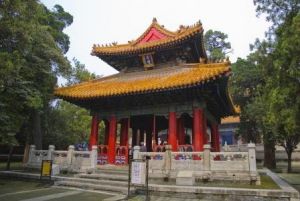Confucius Temple in Qufu
The Temple and Cemetery of Confucius, and the Kong Family Mansion in Qufu all honor Confucius—the great philosopher and educator who lived from 551 BC to 419 BC.
Starting one year after his death and continuing to today, the Temple of Confucius has been used for offering sacrifices to him. The Cemetery of Confucius contains Confucius’ remains as well as that of over 100,000 of his descendants. And the Kong Family Mansions had been expanded over long years to become a very large manor of many buildings for an aristocratic family.
The Temple of Confucius had been continuously expanded into a palatial compound comprising of buildings covered with glazed yellow tiles. From the time of the Han Dynasty (206 BC–AD 220), emperors of various dynasties showed great respect for Confucius and Confucianism. Confucius was bestowed with numerous honorary titles by the feudal rulers. Today, it covers an area of 21.8 ha with ancient buildings laid out in nine courtyards with a total of 446 rooms along a north-south axis. The first three courtyards serve as an entrance for they are mainly gateways and archways. In the fourth courtyard stands a hall with three tiers of roofs, known as Kuiwenge, in which many books given by past emperors are kept. In the seventh courtyard lies the Apricot Pavilion, which is said to be the place where Confucius gave lectures. The main hall of the temple is Dacheng (Great Achievement) Hall, which is 31.89 m high, 54 m wide and 34 m long. The wide roof is supported by 28 pillars, each made of one block of solid rock. Each of the ten pillars in the front of this hall is entwined with two dragons amidst clouds, rockeries and waves, all carved in high bas-relief. A large number of steles and stone reliefs are housed in the temple, extremely valuable for the study of the Chinese culture, art and calligraphy.
